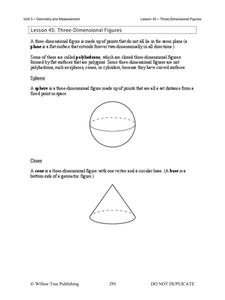Curated OER
Classifying Solids
In this geometry learning exercise, students write the name of the shape, and identify the number of vertices, edges, and faces for 6 e-dimensional shapes. Students draw 3 shapes, and classify groups of pictures.
World Wildlife Fund
Arctic Shapes
In a two-part worksheet, young geometers examine 3-D shapes and describe their attributes in a table. They will be able to draw the shape and name the number of vertices, faces, and edges. In the second part, individuals explore nets of...
Curated OER
Visualize 3-D Objects and Make Nets of Common Solids
Prisms are the focus of this geometry worksheet. Learners count the number of parts of a prism and chart 26 answers. Vocabulary such as: "faces," "edges," and "verticies" are taught. A well-designed math worksheet!
Curated OER
Faces, Vertices, Edges, Shapes
For this geometry worksheet, students solve 25 problems that pertain to shapes, edges, faces and vertices. There is instruction on the page and examples are shown. This page is intended for online use but may be completed on paper.
World Wildlife Fund
Shapes
Investigate the properties of three-dimensional figures with this Arctic-themed math lesson. Beginning with a class discussion about different types of solid figures present in the classroom, young mathematicians are then given a...
Houghton Mifflin Harcourt
Unit 6 Math Vocabulary Cards (Grade 5)
Acute angles, nets, and vertices are only a few terms that a set of flash cards includes. Among the 108 cards, two types are available; word cards printed in bold-faced lettering, and corresponding definition cards equipped with an...
Willow Tree
Three-Dimensional Figures
Time to move into the third dimension! Learn the names of the geometric solids and count faces, edges, and vertices. Then learn to recognize nets that create a given solid.
Curated OER
Geometry
In this rectangles and shapes worksheet, students complete a variety of exercises including counting the number of faces on a solid object, coloring solids to match nets and coloring plane shapes. Students check their answers online as...
Curated OER
Faces, Vertices, Edges
Students identify the parts of three dimensional objects. In this geometry lesson, students find the number of faces, edges and vertices. They differentiate between prisms and polyhedra.
Curated OER
Toothpicks, Gumdrops, and Polyhedrons
Sixth graders use toothpicks and gumdrops to make prisms and pyramids. This helps them explore the relationship betweeen faces, vertices, and edges.
Curated OER
Euler's Theorem
For this Euler's Theorem worksheet, 10th graders solve and complete 15 various types of problems. First, they find the distance and midpoint of a segment given its endpoints. Then, students identify the number of vertices, edges, and...
Curated OER
Three-Dimensional Figures
Sixth graders explore three-dimensional objects. In groups, they create and decorate their own polyhedron design. After identifying the faces, vertices, and edges of the polyhedron, 6th graders determine a relationship between the...
Curated OER
Finding Patterns in Pyramids and Prisms
In this finding patterns in pyramids and prisms worksheet, 4th graders use two tables showing faces, edges and vertices for pyramids and prisms to answer six questions about the patterns.
Curated OER
Three-Dimensional Figures
Sixth graders explore three-dimensional objects. Using various objects found in the classroom, they identify faces, edges, and vertices of objects. Students create their own objects. They describe the polydron, telling the faces,...
Curated OER
2D Polygons and 3D Nets
Students compare and contrast two dimensional polygons and three dimentional nets by examining the differences in drawings. They create three dimensional shapes and label the faces, edges, and vertices. After creating the shapes, they...
Curated OER
Properties of 3-D Shapes
In this properties of 3-D shapes worksheet, students fill in a chart that describes 5 shapes such as a cube, a rectangular prism, and a cylinder. They tell if the shape is a prism, and how many faces, edges, and vertices it has.
Curated OER
Polyhedra: Faces, Edges, and Vertices (3-D Marshmallow Models)
Third graders explore the attributes of 3-dimensional shapes. In this shapes lesson, 3rd graders examine faces, edges, and vertices of 3-dimensional shapes as they construct shapes using marshmallows and toothpicks.
Curated OER
Identifying Solids
In this identifying solids activity, students complete a chart of faces, edges and vertices for four geometric solids, then identify which solid is seen in three pictures.
Curated OER
Shape All Around
Students investigate solid shapes. In this geometry lesson, students take pictures of solid shapes and classify their pictures according to the vocabulary terms: edge, face and vertex. Students present their findings to the class.
Curated OER
Marshmallow Geometry
In this three-dimensional shapes geometry lesson, learners identify geometric solids and name their properties. They define "face," "edge," and "vertex," and construct geometric solids using marshmallows as vertices and toothpicks as edges.
Mathed Up!
2D and 3D Shapes
What a great assessment to give young mathematicians in order to test their knowledge on two- and three-dimensional shapes. Learners name various shapes, identify the number of edges, faces, and vertices, match an unfolded version of a...
Curated OER
3-D Attributes
Students explore geometric solids. In this geometry lesson, students listen to the book The Greedy Triangle by Marilyn Burns, then work in groups to sort geometric solids into various categories. Students define geometric solids...
Curated OER
Pyramids & Prisms: Guler's Formula
Sixth graders compare and contrast two-dimensional shapes to three-dimensional shapes. After watching a demonstration, they make their own shapes using nets printed on paper. To end the lesson, they use the shapes they made and...
Curated OER
Three-Dimensional Play Dough
Fourth graders make models of three-dimensional figures and then use these play dough figures to observe and count the vertices, edges, and faces of the figure.
Other popular searches
- Faces Edges Vertices
- Faces, Edges, Vertices
- Faces, Vertices, Edges
- Faces and Edges and Vertices
- Faces Edges and Vertices
- Prism Faces Edges Vertices
- Faces, Edges, and Vertices
- Faces, Vertices, and Edges
- Faces/edges/vertices

























